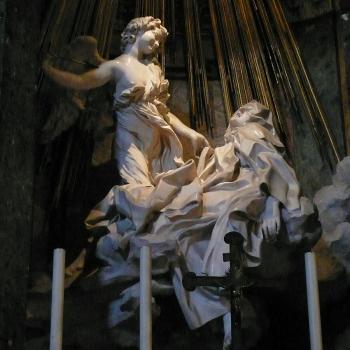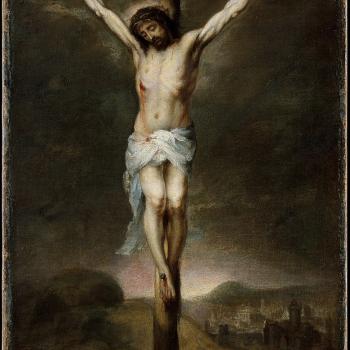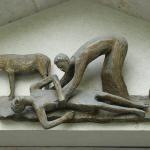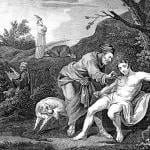That’s what Carrie Frederick Frost hopes to provoke with her slender new book, Maternal Body: A Theology of Incarnation from the Christian East. Frost is an Orthodox theologian and mom of (checks dedication page) five, and her book is not a treatise but an attempt to suggest possible paths for future theological work. It’s introductory, but I in fact did need and want an introduction, and Frost makes several smart choices about how to begin.
Many Christians East and West have written beautifully about the nature of motherhood–Frost quotes St Ephrem the Syrian, I’d throw in St Bernard of Clairvaux, you’ll doubtless have your own favorites–but virtually none of them have actually, how to put this gently?, been literal mothers. (Even the women who have shaped Christian theology have tended to be virgins.) Melinda Selmys wrote a cri de coeur a while back about how Catholic theology evades or distorts the realities of pregnancy and birth; this book agrees with that criticism of much Christian theology more generally, and explores the resources we do have in order to begin a theology of motherhood.
I have two major criticisms, but let me first say what is done well here. Frost addresses the silences of the theologians by looking to iconography and liturgy, where images and understandings of motherhood are worked out in greater depth. I don’t think she wants us to stop at simply noticing the theology of Mary’s contemplative, reclining posture in many Nativity icons. I don’t think she even wants us to stop at noticing and then reflecting on Mary’s contemplation. She hopes (I think) that theological work, the exploration of the implications and consequences of the truths of our faith, can draw us closer to the mysteries of Creation and Incarnation. Possibly most of the specific Orthodox icons, hymns, and prayers she discusses are already super familiar to an Orthodox audience; they weren’t to me, so I loved that part, simply being introduced to the icons and feasts of Mary’s conception and John the Baptist’s. It’s easy to think of “theology” as conclusions and the arguments presented for those conclusions rather than a process or language of reflection. Keeping theological work grounded in the iconography and liturgy of the Church seems like a good way to avoid that error on the part of both the theologian and (perhaps more importantly!) her readers.
Frost is also quite forthright about the flaws she perceives in her own tradition. She’s judicious, obedient but not uncritical, and she suggests ways to shift iconography and prayer to better reflect the created beauty of the maternal body. She’s also interested in what Orthodoxy can learn from the expressions of faith in other churches, both Catholic and Protestant. She wants to share in both directions, showing us what Orthodoxy has and receiving from us the insights expressed in (for example) the Western/Catholic tradition of Maria Lactans imagery. She’s not uncritical of other churches, either!–she’s very clear on where she disagrees with Catholic or Protestant understandings. But she’s submissive to Truth and delighted to find it wherever it’s sheltered.
So okay, I hope by now you have already ordered her book, so I can unburden myself of a couple criticisms. The first is that the book does center much more on Mary than on a theology of motherhood more generally. Obviously Mary’s kind of a paradigmatic mother, and we do see other mothers in the text (including Frost herself!), but because Mary’s motherhood gives the book its structure, she maybe has to become more paradigmatic, or more normative–less weird–than she really is. Marian devotion is a huge part of our understanding of motherhood but this book touches only glancingly, or in a to-be-sure kind of way, on experiences of motherhood which deviate too sharply from Mary’s. Aspects of Marian theology or devotion which emphasize her difference from other mothers are sometimes treated as flaws, as a way to separate Mary from all of us her beloved children, and I don’t think that’s always necessary or helpful.
To pick one specific example, which I know gets into complex East v West discussions of the effects of the Fall, Frost quotes one Orthodox hymn which says Mary “suffered no pangs of birth,” but contrasts as “authentic” a hymn by St Ephrem which says “He emerged with birth-pangs.” Frost emphasizes that this shows a diversity of theology within Orthodoxy, but fwiw, I think defining painful birth as “authentic” birth implies that our authentic nature is fallen and subject to pain. Mary’s painless birth does separate her from our current experiences of birth. But it also reminds us that we weren’t meant or made to give life in pain. Anyway, more broadly the book doesn’t always navigate the difference between personal reflections on Mary and a general theology of motherhood.
The larger criticism, which I realize might sound like it contradicts the last two paragraphs!, is that there is way too little discussion of the sufferings common to motherhood. I know this is just stereotypically Catholic, WHY U NOT TALK ABOUT THE SUFFERING >:|, but it really stood out at the beginning and end of the book. The discussion of conception focuses exclusively on desired conception. Frost discusses infertility in depth, but doesn’t touch on unwanted pregnancy at all. Ambivalence, terror, even horror at pregnancy are not exactly uncommon experiences! Here again Mary doesn’t and shouldn’t share our experience, but any theology of motherhood needs to address this. The icon of Joachim and Anna embracing atop their marriage bed, their garments fluttering in their rush to come together and conceive the Blessed Virgin, is so beautiful. But many, many lives begin in violence, in mistakes, in ambivalence–in every hard emotion and circumstance. This too is Christian motherhood.
And at the end Frost describes the bittersweet “fasting or feasting?” emotions of weaning–and of sending her oldest son away to college, which “in our culture today is considered the ultimate metaphorical act of weaning.” Lol setting aside the ways Mary’s poverty has been mostly absent from the book already (I’m pretty sure the majority of Americans still don’t have a college degree so is this really “our culture”?), I appreciated Frost’s brief discussion of weaning in Scripture and her reflection on the ways weaning is a farewell.
But Mary’s own motherhood hardly ends when she weans Our Lord. Her motherhood included suffering and trauma. Her maternal body agonized at the foot of the Cross. Mary’s own maternal suffering is depicted so physically in (Catholic?) imagery, the sword-pierced heart and the Pieta. Our Lady of Sorrows shares her motherhood with mothers who lost children to addiction, to violence, to suicide; mothers who saw their children sin, suffer, and stray. This too is Christian motherhood.
I don’t think these are merely quibbles, honestly. Even an introductory attempt at a theology of motherhood and the maternal body needs to be also a theology of mothers’ suffering.
So–this is a very good book, which offers helpful frameworks for thinking about many aspects of motherhood (e.g. “the ascetical labor of motherhood”). Frost’s own epilogue notes, “This is a speculative, suggestive, nascent, and imperfect theology of the body.” I hope my criticisms will add to the intervention Frost has performed.
It’s weirdly hard to find clear public-domain images of Our Lady of Sorrows so here’s a nice Maria Lactans, via Wikimedia Commons.












